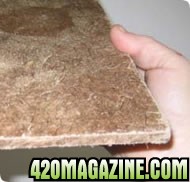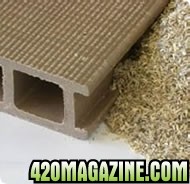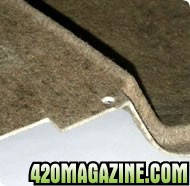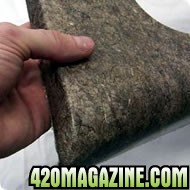Smokin Moose
Fallen Cannabis Warrior & Ex Moderator
The most rapidly expanding application for hemp fiber is as a reinforcement in composites. The blending materials range from thermoplastics such as polypropylene and polyethylene to thermoset fiber such as polyester. The common application is to blend hemp fiber with polypropylene in a nonwoven (felt) mat that is then compression molded to form a three dimensional part. Typical applications include automotive interior substrates, furniture and other consumer products.
Hemp fiber is also being used to produce mineral based composites, in much the same way polypropylene or glass fiber is used to reinforce cement or plaster. The rising price of energy is making these other reinforcing fibers more expensive and the excellent properties and cost of hemp fiber are opening up new applications everyday.
Hemp Fiber Composites for Automotive:

Presently, the single largest use for hemp fiber produced in North America is for automotive composite products. There are a number of ways hemp fiber can be used to create a biofiber based composite for automotive applications. Typically, hemp fiber is blended with polypropylene or polyester fiber to produce a nonwoven (felt) material.
In the case of a hemp fiber composite made from a blend of hemp fiber and a thermoplastic such as polypropylene, the hemp fiber based mat is heated to the melting point of the plastic, then placed into a matched metal mold, and compressed under pressure. The molded hemp fiber and plastic part is removed from the mold, cooled and further attachments or finishing of the part is done. The hemp fiber part would typically be used for interior trim applications such as a door panel, window pillar, package tray or trunk liner.

In the case of a hemp fiber composite made from a blend of hemp fiber and a thermoset resin such as polyester, the hemp fiber based mat is usually placed into a heated matched metal mold, sprayed with the thermoset resin, and then compressed under pressure. The molded hemp fiber based part is finished in the same way as other compression molded materials. There are a wide range of thermoset resins being developed that are compatible with hemp fiber for composite products. Some of these are plant based so that a 100% biocomposite is technically feasible and soon to be in full commercial production using resins based from soy canola or corn.
In addition to hemp fiber nonwoven composites from nonwoven materials it is also possible to make other hemp fiber and plastic composites. The use of injection molding technology is starting to can ground using hemp fiber as a reinforcing material. There are compounding systems that can blend hemp fiber with different thermoplastic and extrude them for use in injection molding, thus allowing hemp fiber to be used in more complex shapes and structures.

The use of plant fibers like hemp as a cost and performance effective reinforcement was largely developed in Europe in the early 1990's and has been embraced by North American car makers at the end of the 1990's. Hemp fiber is of interest to automotive and other applications due to the following features:
* Cost effective.
* High tensile strength and stiffness.
* Ideally suited for needle punched nonwoven products.
* Effective replacement for glass fiber.
* Reduces molding time.
* Weight reduction in finished part.
* Easy to process and recycle.
* Can be customized to meet a variety of specifications and different manufacturing systems.
* Consistent quality and availability of supply is possible.
Hemp Fiber Composites for Consumer Products:
Many of the technologies developed for automotive applications can be used to make consumer composites from hemp fiber. It is possible to use compression molding, injections molding, simple hand lay-ups or hybrid technologies to produce consumer goods. Such products include furniture (chair backs or seats) sporting goods and recreational products , luggage, musical instruments and sound reinforcement gear.
In most applications if the product uses glass fiber then hemp fiber most likely could be substituted as a reinforcement in the product. Given the large number of inquiries we receive from companies wanting to develop hemp fiber composites it is likely you will see some new and novel applications in the market place very soon. Someone, somewhere will begin to mass produce a hemp fiber skateboard or hemp fiber snowboard – it is just a matter of time.
Hemp Fiber Composites for Building Materials:

Beyond automotive the use of hemp fiber and other biofiber materials are expected to make large in-roads into home and commercial construction in the years to come. The applications are numerous and hemp fiber can help innovative companies achieve their goals of implementing sustainable and environmentally sounds building practices that are both cost effective and affordable. Some of the products that are in the works include panel materials, utilizing hemp and earth-friendly binders as an alternative to wood-based panels such as ply-wood. New systems for blending hemp fiber with concrete or stucco are already in place and being refined as your read. Hemp fiber based insulation is available in Europe and detined to be implemented in North America in the foreseeable future. In short, hemp fiber and other bio-fibers will be the new materials in the high-energy cost era that has become a reality.
This hemp composite is included in the structure of Earthrace, the fastest eco-boat on the planet.
Hemp fiber is also being used to produce mineral based composites, in much the same way polypropylene or glass fiber is used to reinforce cement or plaster. The rising price of energy is making these other reinforcing fibers more expensive and the excellent properties and cost of hemp fiber are opening up new applications everyday.
Hemp Fiber Composites for Automotive:

Presently, the single largest use for hemp fiber produced in North America is for automotive composite products. There are a number of ways hemp fiber can be used to create a biofiber based composite for automotive applications. Typically, hemp fiber is blended with polypropylene or polyester fiber to produce a nonwoven (felt) material.
In the case of a hemp fiber composite made from a blend of hemp fiber and a thermoplastic such as polypropylene, the hemp fiber based mat is heated to the melting point of the plastic, then placed into a matched metal mold, and compressed under pressure. The molded hemp fiber and plastic part is removed from the mold, cooled and further attachments or finishing of the part is done. The hemp fiber part would typically be used for interior trim applications such as a door panel, window pillar, package tray or trunk liner.

In the case of a hemp fiber composite made from a blend of hemp fiber and a thermoset resin such as polyester, the hemp fiber based mat is usually placed into a heated matched metal mold, sprayed with the thermoset resin, and then compressed under pressure. The molded hemp fiber based part is finished in the same way as other compression molded materials. There are a wide range of thermoset resins being developed that are compatible with hemp fiber for composite products. Some of these are plant based so that a 100% biocomposite is technically feasible and soon to be in full commercial production using resins based from soy canola or corn.
In addition to hemp fiber nonwoven composites from nonwoven materials it is also possible to make other hemp fiber and plastic composites. The use of injection molding technology is starting to can ground using hemp fiber as a reinforcing material. There are compounding systems that can blend hemp fiber with different thermoplastic and extrude them for use in injection molding, thus allowing hemp fiber to be used in more complex shapes and structures.

The use of plant fibers like hemp as a cost and performance effective reinforcement was largely developed in Europe in the early 1990's and has been embraced by North American car makers at the end of the 1990's. Hemp fiber is of interest to automotive and other applications due to the following features:
* Cost effective.
* High tensile strength and stiffness.
* Ideally suited for needle punched nonwoven products.
* Effective replacement for glass fiber.
* Reduces molding time.
* Weight reduction in finished part.
* Easy to process and recycle.
* Can be customized to meet a variety of specifications and different manufacturing systems.
* Consistent quality and availability of supply is possible.
Hemp Fiber Composites for Consumer Products:
Many of the technologies developed for automotive applications can be used to make consumer composites from hemp fiber. It is possible to use compression molding, injections molding, simple hand lay-ups or hybrid technologies to produce consumer goods. Such products include furniture (chair backs or seats) sporting goods and recreational products , luggage, musical instruments and sound reinforcement gear.
In most applications if the product uses glass fiber then hemp fiber most likely could be substituted as a reinforcement in the product. Given the large number of inquiries we receive from companies wanting to develop hemp fiber composites it is likely you will see some new and novel applications in the market place very soon. Someone, somewhere will begin to mass produce a hemp fiber skateboard or hemp fiber snowboard – it is just a matter of time.
Hemp Fiber Composites for Building Materials:

Beyond automotive the use of hemp fiber and other biofiber materials are expected to make large in-roads into home and commercial construction in the years to come. The applications are numerous and hemp fiber can help innovative companies achieve their goals of implementing sustainable and environmentally sounds building practices that are both cost effective and affordable. Some of the products that are in the works include panel materials, utilizing hemp and earth-friendly binders as an alternative to wood-based panels such as ply-wood. New systems for blending hemp fiber with concrete or stucco are already in place and being refined as your read. Hemp fiber based insulation is available in Europe and detined to be implemented in North America in the foreseeable future. In short, hemp fiber and other bio-fibers will be the new materials in the high-energy cost era that has become a reality.
This hemp composite is included in the structure of Earthrace, the fastest eco-boat on the planet.



